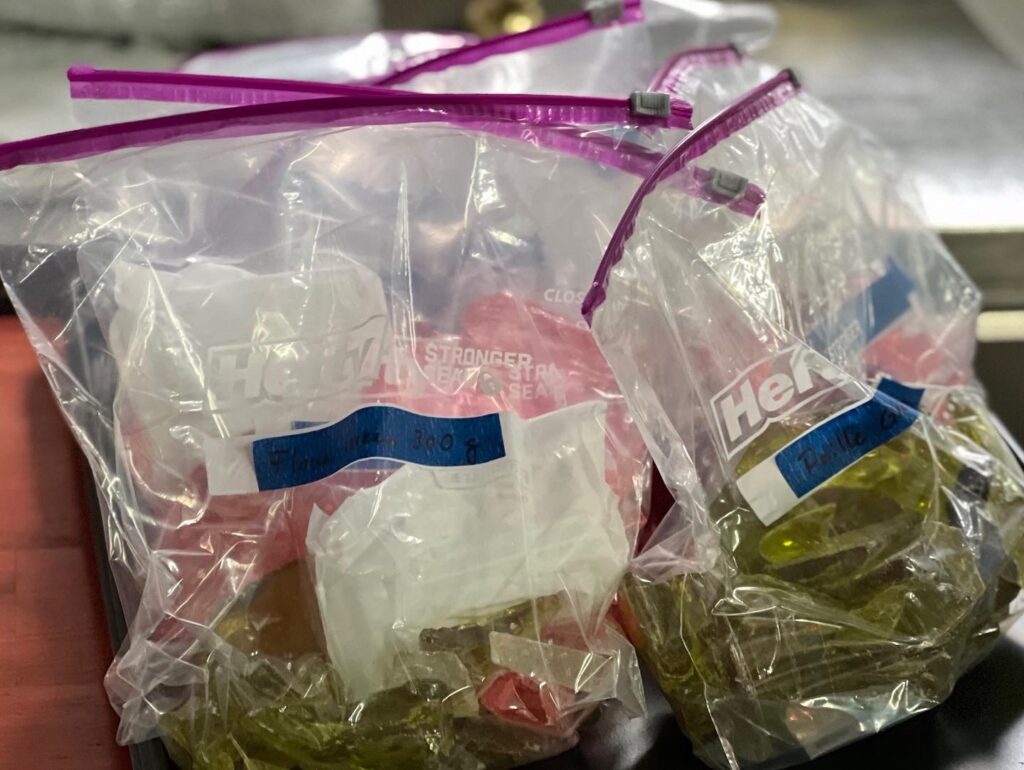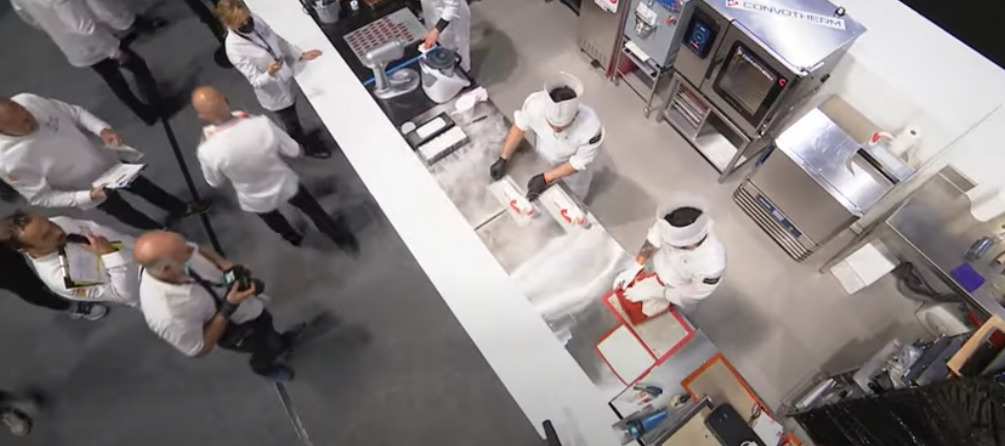Previously in Part One, we covered a brief history of the Coupe du Monde de la Pâtisserie, how the teams are selected, and what they should expect at this year’s competition. Part Two discussed who the judges are, the judging process, and how each category is scored.

In Part Three of our continuing series of Understanding the Coupe du Monde de la Pâtisserie, we will discuss the team’s laboratory or work kitchen setup and breakdown, products and equipment that each team may and may not use, as well as the first of the artistic tests – the whole chocolate cake/dessert to share category.
Recipes
After the team develops, tests, and finalizes their recipes they must be sent to the organization. Before 6 January 2023, each team must forward a detailed description, in French and English, of every recipe that will be prepared at the competition. Among the information included in each recipe are measurements, ingredients, and detailed preparation methods.
The I.O.C. requires that all recipes presented must be original.
According to the 2023 Rules and Regulations, “No modifications will be accepted after this date. No other file may be presented to the judges during the contest.”
The Organizing Secretary compiles each team’s recipes and secures them until the competition. “The description and method for each recipe are presented to each Jury member during the contest,” read the official rules. “The Organising Secretariat guarantees utmost confidentiality for the document until the start of the test.”
Each team must abide by the organization’s list of products that are permitted and not permitted for the competition. If a team is found in violation of any non-authorized products, they will be confiscated by the International Organizing Committee.

Non-authorized Products
- Any preparations including assembled or mixed raw ingredients
- Ready-made icing products
- Decorated elements and semi-finished items (prints, transfers, gun moulds, hollow chocolate balls, paste balls, etc)
- Colored and/or assembled pastillage
- Accompanying alcoholic beverages
- Colouring agents isomalt, titanium oxide (E171) or iron oxides (E172) for the tasting test only
Authorized products brought by the teams
- Milk, flour, eggs – individually weighed, not mixed or assembled
- All weights for the recipes
- Sugar, sugar syrup, icing sugar, granulated sugar, carbonation drops, or non-glossy sugar sheets (ready-to-heat). Cooked, tinted sugar – providing it is reworked during the contest
- Pastillage – white only, cut-out, imprinted, shaped, but non-tinted and non-assembled
- Any other specific products not provided by the organizers, with no visible brand names (e.g. food colorings, aromas, etc.)
- Alcoholic products that are part of the recipe
Products that are manufactured by sponsors, such as chocolate (Valrhona) and fruit purees (Capfruit), and others must be used as part of each team’s recipe.
“Orders must correspond to the quantities required to prepare your recipes within quantity limits set by the partners,” read the rules. “They must be from the partners’ products list sent by the Organising Secretariat.
The Coupe de Monde de la Pâtisserie states that as part of their commitment to being eco-responsible, they will “pay close attention” to the waste limitations. Commissioners for the I.O.C. will check each team’s order form against their recipes.
Equipment
The organizers will provide each country will receive a detailed list of equipment that will be provided for the competition. Each country must use the equipment provided to them.
There will be 12 competition laboratories or kitchens – 10 for use by the countries and two will be reserved for the ice carving portion of the competition.

At the start of each day’s competition, each laboratory will be identical in nature to insure fairness. The organization will provide a majority of the equipment including, but not limited to two induction stove tops – two hobs, one Convotherm GN 1/1 oven, one worktop, one water supply, one granite top refrigerator unit, one chocolate tempering machine, two GN 1/1 racks (speed racks), one stand for non-recyclable waste bags, and one 3-compartment recycling bin.

Each country may bring some of its own equipment and utensils (racks, baking trays, GN 1/1 racks, chocolate spray gun, microwave, sugar lamps, etc.), however, only in reasonable quantities. The rules state that glue guns are strictly forbidden, as well as covering the worktops and units in any type of wooden dressing or other materials.
Anything that is brought in may not exceed 170cm in height (5.5 feet) and obstruct the view of the audience. In addition, any brand names on equipment that are brought in and is not from one of the official sponsors must be covered up. They also may not obscure the sponsor’s advertising spaces (logos, stickers, etc).
Other rules include:
- All work done must be within the laboratory and in full view of the Jury
- During the tests, the entrance to the laboratories must remain open and readily accessible to the I.O.C.
- Each laboratory is outfitted with a specific amount of power and each candidate must respect the maximum power available. The Organizers will not be responsible for any overvoltage resulting in power outages, damaged equipment, etc. due to excessive power requirements and use.
- All provided equipment and appliances will be placed in the laboratories prior to the arrival of the competitors. Should any competitor move any of these items it will result in elimination from the competition.
Installation & Cleaning
Each country will be allotted two hours, the night before their scheduled tests, to bring in materials and equipment. This time is broken down in two one-hour blocks.
The first hour is allotted to unloading all their equipment in front of the kitchen’s loading zone. The team will be permitted to have up to five helpers or Staff Members to assist in the unloading and can accompany the candidates to the entrance of the laboratory.
During the second hour, only the three candidates are allowed to settle in the kitchen. No one else may enter with them.

Once the competition is over, the candidates, along with their Staff Members, have 30 minutes to completely clean and clear the kitchen for the next competitors. Afterward, the laboratories will be inspected and an inventory will be taken of all equipment in the presence of the candidates and a member of the Laboratory Committee. The rules state that “the kitchen and equipment must be clean. Failure to comply with this point, as reported in the inventory by the I.O.C. and the official bailiff will entail the application of penalty points.”
Each team may only leave the laboratories after the kitchen has been cleaned, inventoried, inspected, confirmed, and signed off by the I.O.C.
The Coupe du Monde de la Pâtisserie assigns a theme for each of the competitions. As mentioned in a previous article, this year’s theme is Climate Change. Each country’s tasting tests and centerpieces must reflect this theme. How this theme is interpreted is left up to each team.
Each team is required to create four tasting tests: Whole Chocolate Cake/Dessert to Share, Frozen Dessert, Frozen Lollipops, and Restaurant-style Dessert. Below, we will cover the requirements for the Whole Chocolate Cake/Dessert to Share.
Tasting Test – Whole Chocolate Cake/Dessert to Share
Each team is required to create four chocolate desserts to share. They should be identical in shape, composition, and finish, as well as serve eight individuals. The judges tasting portions should be between 80 g – 120 g (2.82 – 4.23 ounces) each.
The chocolate dessert must be composed predominately of chocolate from the proposed list. Any chocolate that is not on the list is not permitted.
As mentioned in a previous article, titanium dioxide (E171) or iron oxides (E172) are not permitted. Additionally, any coloring agents are not allowed in any of the shared desserts.
Temperature plays an important role as well. The rules state that any shared desserts “must not be in negative temperatures or in contact with a technology involving negative temperatures. This includes the use of dry ice, cold spray, or other means.

As with all other creations, the shared dessert must be made entirely on the premises. However, the mock dessert for the presentation table, may be brought already finished.
The whole chocolate cake/dessert must be presented on its own. It cannot be in a mold, terrine, baking tray, circle, or any other integrated container. However, the competitors may use flexible and hard molds, baking stencils, and frames to prepare the dessert.
The presentation molds that the four desserts sit on can be of any material, shape, and look, but they all must be identical and supplied by each team.
The mock dessert must be identical in every way to the chocolate cake/desserts presented to the judges including completely composed of edible products. When the teams are setting up their contest laboratories, they must present all of their mock desserts at that time.
“The raw materials must be prepared in advance and weighed by the teams in their practice laboratories,” reads the official rules. “These will be verified by the I.O.C. when you settle in your kitchen on the eve of the contest. Consistent with our CSR approach, coherence between the weights and the recipes sent ahead of the event will be assessed. The I.O.C. will carry out random checks on one or several of the recipes presented by the team.”

They go on to inform each team that if they are using chocolate, fruit pureés, and dairy products they must be from Valrhona, Capfruit, and Debic, official sponsors of the competition. If they fail to use products from an official sponsor the team will incur penalty points against their final score.